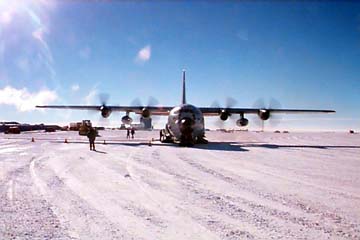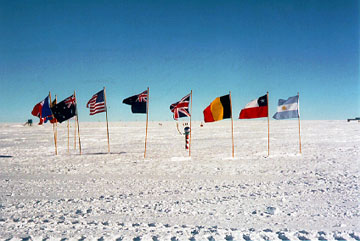
|
Nov. 20, 1998 Letter 2: McMurdo to S. Pole Dear Everyone, Once us Polees, as we're called in McMurdo because we are in transit to the South Pole, were put through our very hurried and not too friendly Sunday evening briefing, had dinner and found our rooms; we gradually congregated at the Movement Control Center (MCC) to collect our bags. It was there that we heard the first rumor that we might be flying to the pole in the morning! McMurdo computers were down so we hung around until this rumor could be verified. Soon enough personnel showed up with their hand written manifest and told us to be at bag-drag by 9:30 p.m. This quick turnaround was unusual but weather was apparently good at the pole. Based on my past experiences and those of most others, I was expecting to be at McMurdo for a least a day or more. The S. Pole Station was already delayed in opening due to weather and was very interested in getting their people in as soon as possible. Les and I were on their priority list because the communications department needed 24-hour coverage. Others remained in Christchurch and McMurdo for a week or longer due to lack of flights as weather conditions worsened. At this point I rushed off to my room for my hand-carry and found my prescription Diamox. Les and I immediately downed a tablet. I did a best guess at number of hours and figured we could each get 3 in us before landing at the S. Pole. That still wasn't the recommended 24-48 hours in advance, but without knowing when we would fly from Christchurch or McMurdo it was the best I could do. My experience of 2 years ago at the geographic South Pole left me with a healthy respect for high altitude. I was determined to be as prepared as I could under the circumstances. For the next couple hours we hung out in our room that was coincidentally the same one we were assigned two years ago when we flew to McMurdo. A friend of ours stationed in McMurdo who had worked with Les TDY (temporary duty) at the S. Pole Station came by to visit while we repacked our issued orange canvas carry-on bags (1 per person) for the bag-drag. Once our hold baggage is weighed at bag-drag and is palletized, our carry-on is all that we have to live out of if our flight is delayed. Last time, we lived out of our carry-on for five days in McMurdo. Luckily, we did not collect our hold baggage from our arrival so we did not have to carry it back to the MCC! At bag-drag we are required to wear or have in hand all of the ECW clothing we are to wear on the flight. We are then individually weighed with this gear along with our carry-on bag on a cargo scale. Cargo and passenger weights are carefully monitored for Antarctic flights. It was nearly 11 p.m. when we got to bed and tried to sleep. In this now 24 hours of brightness, the window shade in our room did not block out the sunshine. It was a short "night". The next morning the weather turned to Condition 2, which is less than perfect at a wind chill of -70 F and decreased visibility due to blowing snow. This was quite a contrast to the beautifully clear, calm and -20 F of our arrival the previous day. Our now smaller group of 23 began to wonder if we would fly. We were held in running vans or a portable waiting lounge (heated, but not warm) for a delay of well over an hour. Finally we boarded the C130. With ear plugs and brown bag lunches for everyone, we settled in for our 3 hour flight inland to the geographic S. Pole. This flight was less crowded as it was mainly a cargo flight and we were able to stretch out our legs, stand up, and stumble around and over cargo to peer out the tiny windows at the infinity of whiteness. The rivers, oceans, and beaches of ice configurations and the glaciers fascinate me with their endless beauty. I can gaze at them tirelessly. Eventually hunger set in and we began rummaging through our lunch bags. Maybe I have been missing something all my life, but I have never before been served a sandwich of white grated cheese and chunky pineapple pieces. Little slivers of cheese cascaded to the floor of the aircraft not to mention a chunk or so of pineapple as we made faces at each other across the width of the plane. I was wondering if I had boarded the wrong flight and was headed for Hawaii. The second sandwich was sliced ham on white buttered bread. I pulled out the ham, plopped it on top of the cheese-pineapple affair and had myself a Hawaiian sandwich. Hunger does amazing things. Anyway, I figured if this is done to pizza, why not a sandwich! Maybe it was just me, but the closer we got to the S. Pole, the colder it became inside the aircraft. Finally, we arrived only to begin circling. We didn't relax until we felt the C130 begin it's approach to the skiway. Others before and after us were unable to land due to weather and returned the 3 hours to McMurdo only to try again the next day. As the C130 Hercules (we call them Hercs) with lowered skis (no wheels here) skied a portion of the 2 miles of skiway, the cargo hold door at the rear of the plane was opened blasting us with incredible brightness and severe coldness. We knew what was happening this time and were all geared and goggled up ahead of time. Not a speck of skin showed. The first-timers watched those of us returning and quickly followed our lead. It was November second.
 A Herc at the South Pole Station. Photo by Chris Rock.
More on high altitude illness, the details of our first week at the Amundsen-Scott South Pole Station and the Antarctic storm will follow in my next letter. I also promised to spend some time discussing our ECW clothing. On Nov. 4, Peter Hillary, the son of Sir Edmund Hillary, departed Scott Base near McMurdo, Antarctica with 2 others for the South Pole Station. They aim to become the longest unsupported ice trek of the century. We hope to meet Peter and his party here sometime in December. If you would like to follow their adventure check out: http://www.icetrek.org/live.htm. Following I have enclosed Victoria's (one of our station meteorologists) basic explanation of physio-altitude and Dar and John's (two more of our meteorologists) weekly climatological summary. Don't forget to calculate wind chill to our ambient temperature to determine how cold it really is here! Yes, we are still gasping for air!
Best regards,
Sandra Kolb,ASA
The main reason for this is the spin of the earth. As the earth spins, it forces the atmosphere to "bunch up" at the equator and become thinner at the poles. This is due the centrifigual force of the earth. Since we are at the pole, the speed of the earth is 0 mph. The centrifigual force draws the atmosphere toward the equator, because that is where the speed of the earth is the greatest. Because of the effect of the atmosphere "bunching up" at the equator, the air pressure at 9300 feet in the midlatitudes and at the equator is more than it is at the poles. As an example, you're climbing Pike's Peak, and get to 9300 feet. You measure the air pressure at 716 millibars. While at the south pole, elev. 9300 ft., the air pressure is 686 millibars (pressure altitude 10400 feet). If you continued to climb Pike's Peak and measure the air pressure at 10400 feet it would be 686 millibars. Victoria MET (South Pole Station Meteorology Dept.)
Date: Mon, 2 Nov 1998 01:48:20 +1200
Subject: SOUTH POLE MONTHLY CLIMATOLOGICAL SUMMARY FOR OCTOBER
1998
SOUTH POLE STATION ANTARCTICA. OCTOBER 1998 CLIMATE SUMMARY.
Temperature:
Avg temp................ -55.0(C)/-67.0(F)
Departure from normal... - 3.8(C)/- 6.8(F)
Max temp................ -37.9(C)/- 36.2(F) on day 26
Min temp................ -66.8(C)/- 88.2(F) on day 4
Sky cover:
Avg cloud cover (8ths).... 06
Days clear................ 06
Days partly cloudy........ 10
Days cloudy............... 15
Wind:
Avg wind speed............ 11.6 mph or 10.1 kts.
Prevailing wind direction (grid) North or 020 degrees
Max wind.................. 29 mph or 25 kts on day 12
Max wind direction........ Grid North
Avg vectored wind......... 062 degrees at 8.4 knots
Station pressure:
Avg pressure........... 677.4 mbs or 20.004 In. Hg.
Departure from normal.. + 0.3 mbs or +0.009 In. Hg.
Highest pressure....... 697.0 mbs or 20.582 In. Hg. on day 15
Lowest pressure........ 663.3 mbs or 19.587 In. Hg. on day 21
Sunshine:
Sunset on 21 March, Sunrise on 23 September
Average hours/day........ 17.5
Percent of possible...... 73%
Snowfall..... Trace; Avg net change at snow stakes -0.199 inches.
Visibility... 4 days with a visibility of 1/4 mile or less.
Balloon flight data:
Number of Soundings for the month... 37
Avg height of Soundings.... 75.5 mbs or 19909 meters above MSL
Highest Sounding........... 4.3 mbs or 35267 meters above MSL
on the day 23/00Z sounding.
Remarks:
1 Sounding was missed.
15 Soundings were terminated below 50 mbs.
9 Soundings were terminated below 100 mbs.
13 Soundings were terminated above 100 mbs.
Records:
Day 7 - A minimum temperature of -66.4(C)/-87.5(F) broke the
previous record of -64.3(C)/-83.7(F) set in 1994.
Day 8 - A minimum temperature of -66.7(C)/-88.1(F) tied the previous
record set in 1977.
Day 10 - A minimum temperature of -66.3(C)/-87.3(F) broke the
previous record of -66.0(C)/-86.8(F) set in 1989.
Prepared by: John Gallagher/Dar Gibson
|


